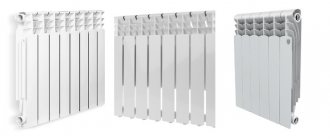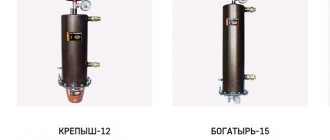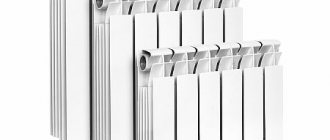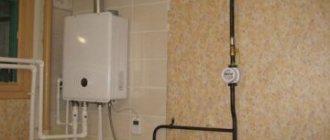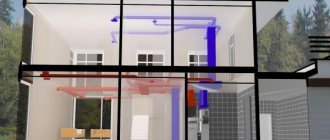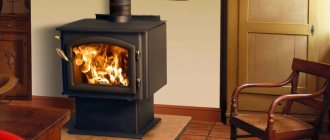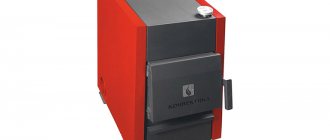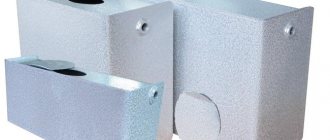Buying a heating radiator (HR) is not a trivial task. There are many models, they cost differently, and it is not always clear which of those presented on store shelves meets our requirements. Therefore, we will save your time and tell you what to consider when choosing. We bring to your attention a rating of the 20 best heating radiators for apartments and private houses. Choose any of them - you won't go wrong!
Which brand of heating radiator is better to choose?
Buying a heating radiator (HR) for a home is a non-trivial task due to the huge variety of brands, manufacturers, product lines and new products constantly added to the market. In order not to get confused in all this, to begin with, experts analyzed the presented manufacturers from all over the world, assessed their products, reputation, stated guarantees and offers.
The following brands made the list of leaders:
- Royal Thermo is a domestic manufacturer whose products are distinguished by Italian design. For several decades now, radiators of this brand have been supplied to the Russian and Eastern European markets, these are mainly bimetallic and aluminum models. Along with increased heat transfer, most products have low prices.
- Rifar is the best manufacturer of RO in Russia, according to buyers and experts, operating since 2002. Each model has good performance characteristics, and most importantly, is inexpensive. Many products come with a 10-year warranty, and bimetallic and aluminum models are in high demand.
- Rommer is another leading manufacturer from Russia, offering durable sectional radiators of various types. All products comply with European quality standards, have high heat transfer, durability, resistance to clogging, and small dimensions.
- Teplopribor is a domestic company that develops modern, durable RO devices with an emphasis on impeccable design and quality, innovation and their implementation. Each unit of goods complies with GOST 31311, the main part of the products are aluminum and bimetallic devices. The brand has several of its own patented technologies.
- Sira is an Italian brand with extensive experience in producing PO. Its products have been supplied to the Russian market since 1961. The main slogan of the company is the creation of long-term values, ideas, concepts and innovations. Assembly takes place in China, and each new unit offers improved performance.
- Könner is a domestic manufacturer with a German name and Chinese production. All products have a service guarantee of 15 years and above. Könner is a modern design, high power, compact dimensions and weight.
- Retrostyle is a Russian company founded in 2011. Most of the products are cast iron ROs with an antique design. Since the unesthetic appearance of cast iron appliances drove them out of the market, the company decided to focus on this parameter.
- Exemet is a company from Russia, whose products began appearing on the market in 2013. These are mainly cast-iron retro models, stoves and fireplaces. The design department and several leading designers are responsible for the design. Before being released for sale, each unit undergoes hydraulic tests.
- Global is the No. 1 brand worldwide in sales of bimetallic and aluminum heating systems. The activity has been carried out since 1971, all modern products are adapted to the harsh Russian winters and low temperatures. All products are protected by a 10-year warranty.
- Lammin is a Finnish manufacturer of aluminum and bimetallic heating devices of European quality. The batteries are available in 2 types - Eco and Premium, differing in technical parameters and prices. Differences from many other brands - anti-corrosion properties, high-tech painting, unique alloy, increased heat transfer.
- Valfex is a Turkish brand with a dealer in Russia, creating heating devices only on the basis of modern technologies and innovations. During production, the high pressure casting method is used. The assortment is universal in its method of operation; before going on sale, each unit undergoes testing and certification.
- Ogint - despite the fact that this is a Russian brand, production is carried out in China. Most of the products belong to the budget series with low prices; the technical characteristics, properties and capabilities of each heating device are moderate.
- Arbonia is a German company with a Russian representative office. The advantageous differences in comparison with competitors are the high quality of each device, a design solution that will transform any interior, modern technologies and declared durability.
- Kermi is a popular German brand with over 50 years of experience. The best ratings were given to steel devices, profile and smooth heating panels. The high price is justified by the brand’s impeccable reputation and guarantees of long service.
- Buderus is one of the oldest brands produced by RO; the German brand was founded back in 1731. Here you can see the inherent German pedantry to the smallest details and quality. In the assortment today you can see classic and reinforced models; the latter have serious technical characteristics that hardly anyone can compare with.
- Axis is a Russian company known in the domestic market and in the former CIS countries for the production of heating boilers. The main activity today is aimed at the development and sale of steel radiators at low prices, in a light, unobtrusive design, with a long service life. Italian equipment of the latest generation is responsible for quality.
- Lideya is an iron foundry in Belarus, which today supplies heating devices for export to the countries of the former CIS and Europe. Most modern products are presented in the form of panel radiators for residential and industrial premises, except for those in an aggressive, humid environment. Their advantages are affordable prices, easy installation, good thermal conductivity, and aesthetics.
The best water leak sensors
For a private house or apartment?
There are dozens and hundreds of companies specializing in the production of radioactive materials. The competition is crazy. Marketers are coming up with new arguments in favor of their products. This makes the choice of characteristics richer, and making a purchase more difficult for the average buyer. Let's start with the simplest thing.
If you need a device for a private house or apartment with an individual heating system, then choose by power and design. Those. We saw a model we liked in appearance, selected it based on power/size – and that’s it. For an apartment in a multi-storey building, where the coolant is supplied through the pipes of a centralized heating system, you also need to take into account the operating pressure set by the manufacturer. It should not be lower than 10-12 atmospheres. Otherwise, the structure will tear when water is supplied.
Now let’s look at the types of heating radiators, traditionally presenting the data in the form of a “tiny” table.
Device options and their features
| Comparison criterion | Varieties | Characteristics |
| Execution | Sectional |
|
| Tubular |
| |
| Panel |
| |
| Radiator material | Cast iron |
|
| Steel |
| |
| Aluminum |
| |
| Bimetal (steel+aluminum) |
| |
| Copper |
| |
| Gasket material | Silicone | Withstands high temperatures, effectively compensating for the expansion of metal structures. Ideal for low pressure heating systems, for example in private homes. |
| Paronitis | Paronite is pressed rubber mixed with asbestos and other components. Durable, withstands high temperatures. It is most often used in centralized heating systems. | |
| Fluoroplastic | A product made of heat-resistant polymer that can be installed without lubrication. Withstands exposure to any type of coolant. | |
| Cardboard | Impregnated with oil paint, special cardboard successfully copes with its function in aluminum and bimetallic RO installed in private homes. | |
| Coolant | Water | We are not talking about plain water, but about specially prepared water. This is exactly what circulates in the centralized heating system. It limits the content of hardness salts (due to which salt deposits form in the pipes - scale) and oxygen (due to which the material corrodes and breaks down). Water requirements in the EU and the Russian Federation are different, so when purchasing a foreign-made heating radiator, it is recommended to take into account the chemical composition of the water in your heating system. If desired, you can find it out at the Housing Office. |
| Antifreeze | Antifreezes or “anti-freeze” agents are used for systems with an individual heating circuit. They are needed if there is a risk of the coolant freezing due to the boiler being turned off. As you know, coolant is always in the system. If, for example, in winter the water in the system freezes, then due to expansion it will rupture the pipes, radiator, etc. Antifreeze does not freeze at average sub-zero temperatures. Ethylene glycol, propylene glycol, and alcohol solutions can serve as such coolants. | |
| Installation location | Stationary | Traditional heating radiators installed in most apartments. Mounting to the wall is carried out using special pin or corner brackets |
| Floor-standing | The same as stationary devices, only they are installed on special legs. | |
| Operating pressure* | up to 10 atm. | Such values are predominantly typical for panel-type devices. |
| up to 20 atm. and higher | For tubular and sectional RO. | |
| Center distance | 350, 400, 500, 600, 700 mm | The distance between the axes of horizontal collectors, along which a device is selected for connection to the existing pipe distribution. |
| Connection method | Lateral one-sided. (subtype of side connection) | The most common and effective solution in terms of using the capabilities of RO. Connection from the side: from above - to the pipe supplying coolant, from below - to the outlet. |
| Diagonal (subtype of lateral connection) | Most often used when connecting long devices (from 2 m and above), which allows the coolant to be evenly distributed throughout the entire volume of the structure. Inlet from above, outlet from the lower opposite side. | |
| Saddle (subtype of side connection) | For sectional ROs when it is impossible to use other methods. Inlet and outlet from the bottom on opposite sides of the device. In this case, the heat exchanger power may drop by 10-20%. | |
| Lower | For connecting panel RO with hidden pipe routing under the floor. Inlet and outlet from below at a short distance. The efficiency of the radiator is lower than with lateral and diagonal connections. | |
| Thermal power** | values in a wide range | Characterizes the radiator’s ability to transfer a certain amount of heat from the coolant to the room per hour of operation. It depends not only on the size and design of the RO, but also on the temperature of the coolant, as well as the air in the room. |
| Dimensions | On average: height from 260 to 800 mm, width from 270 to 1800 mm, depth from 50 to 100 mm | Directly affect the thermal power of the device, because The volume of coolant circulating in the device depends on this. |
* Before choosing a device, you need to check with the housing office about the maximum pressure in the heating system. Remember that all radiators except aluminum ones are suitable for a centralized heating system!
** We are often asked about how to choose the right heating radiator based on power. To make life easier for you and yourself, we have developed a convenient calculator. Enjoy it for your health!
For those who want to estimate the thermal power on their own, you can use the following method. We determine the required values per unit area of the room: 100 W/m2 – one window and one external wall; 120 W/m2 – one window and two external walls (corner room); 130 W/m2 – two windows and two external walls (corner room). For example, there is a corner room of 20 m2 with two windows. Then the approximate power of the RO will be: 20 × 130 = 2600 W. Let's make an allowance for the fact that the nameplate characteristics of radiators are tied to the ideal operating conditions of the device - 10% is quite enough. In total, we get the required thermal power: 2600 × 1.1 = 2860 W.
All that remains is to decide on the desired model, which you can find among the 20 devices we have selected.
Brief description of RO models from the rating
| Brand and country of manufacture | Model and section/panel dimensions (W×H×D) | Material, rated heat flux per section/panel, W | Approximate price per unit/section |
| 1. Global (Italy) | STYLE PLUS 500 (80×575×95) | bimetal, 185 | from 1041 rub. |
| 2. RIFAR (RF) | ALP-500 (81×570×75 mm) | bimetal, 158 | from 630 rub. |
| 3. SIRA (Italy) | RS 500 (80×572×95) | bimetal, 201 | from 850 rub. |
| 4. RIFAR (RF) | Monolit 500 (80×577×100) | bimetal, 196 | from 850 rub. |
| 5. Royal Thermo (Italy) | PianoForte 500 (80×591×100) | bimetal, 185 | from 1500 rub. |
| 6. Global (Italy) | ISEO 500 (80×582×80) | aluminum, 180 | from 790 rub. |
| 7. Thermal (RF) | Standard Plus 500 (79×531×72) | aluminum, 198 | from 400 rub. |
| 8. Oasis (RF) | Al 500/80 (79×531×72) | aluminum, 170 | from 420 rub. |
| 9. Sira (Italy) | ALICE ROYAL 95/500 (80×580×95) | aluminum, 190 | from 560 rub. |
| 10. Royal Thermo (RF) | Indigo 500 (80×591×100) | aluminum, 185 | from 630 rub. |
| 11. Buderus (Germany) | Logatrend K-Profil 33 300 1200 (1200×300×155) | steel, 670 | from 2000 rub. |
| 12. KZTO (RF) | Harmony 2-500-12 (70×545×80) | steel, 180 | from 2250 rub. |
| 13. Lideya (Belarus) | type 22 500×1000 LU 22-510 (1000×500×47) | steel, 697 | from 2850 rub. |
| 14. Kermi (Germany) | FKO 22 0510 (1000×500×100) | steel, 965 | from 2650 rub. |
| 15. Viadrus (Czech Republic) | Style (60×580×130) | cast iron, 70 | from 1500 rub. |
| 16. MZOO (Belarus) | MS-140M-05 (104×588×140) | cast iron, 160 | from 500 rub. |
| 17. EXEMET (RF) | Modern 3-745/600 (45×745×100) | cast iron, 102 | from 2000 rub. |
| 18. Terma (Poland) | Aero H (325×900) | steel, 290 | from 41,000 rub. |
| 19. Arbonia (Switzerland, Germany) | Karotherm KM90 (500×943×22) | steel, 481 | from 100,000 rub. |
| 20. GuRaTec (Germany) | Apollo 765/05 (76×768×250) | cast iron, 145 | from 6600 rub. |
In addition to the heat exchanger itself, do not forget about the control valves (thermal head) and the Mayevsky tap (if not included), which must be purchased separately. In some cases, the same applies to installation kits. Single-pipe heating systems will require a bypass.
We offer you a small rating that contains the best models of heating radiators. To make it easier to compare, we tried to select devices with the same number of sections - most often there will be 6 of them. This border solution is most in demand for standard apartments. All prices are for comparison purposes only.
Heating radiator rating
How were the best heating radiators of 2022 selected? In compiling the TOP list, experts assessed and compared those brands and models that are in greatest demand in the market and trusted by customers. In total, several dozen nominees were considered, after which the leaders were determined based on important technical criteria:
- Execution – sectional, tubular, panel;
- Body material – cast iron, steel, aluminum, bimetal, copper;
- Coolant – water, antifreeze;
- Installation – floor, stationary method;
- Working pressure – up to 10 atmospheres, up to 20 and higher;
- Thermal power - heat transfer in relation to the area of the room;
- Dimensions – height, width, depth, weight.
The ratio of quality, appearance, and price of each nominee was taken into account. Reviews from those who have personally used this or that unit are also important when compiling the rating. They mention the ease of installation and maintenance of ROs, their resistance to corrosion and pollution, and the harmonious combination of design and interior.
The best heaters for a summer house
Table. Comparison of operating pressure and application areas of various radiators
| Steel panel | Steel tubular | Aluminum | Bimetallic | Cast iron | |||||||
| Working pressure, atm. | 6 — 10 | 8 — 15 | 6 — 25 | 20 — 30 | 6 — 9 | ||||||
| For a private home | |||||||||||
| For apartment | |||||||||||
| Price | Low | Very high for decorative models | Average | High | On the MC model - low, on decorative models - high | ||||||
So we have looked at all the common heating radiators; you will have to decide which ones are best in a private home yourself, using this article as a hint, and not a guide to action. As you can see, any radiators for heating a private home require certain operating conditions, and they must be selected taking into account the general technical condition and capabilities of the heating system itself as a whole. Much depends on the budget; when choosing any type of battery, you can find a middle ground in terms of technical characteristics and price range.
In my opinion, in this case, it is most advisable to consider 2 types of radiators: panel steel radiators or aluminum ones. But still, if you compare them with each other, then steel ones are probably more practical, more reliable, more efficient and cheaper.
The best cast iron heating radiators
The very first model of radiators was made of cast iron, but modern modifications have greatly changed for the better. At first they were replaced by newfangled aluminum devices, and after some time, cast iron batteries became almost luxury items for a lot of money. On sale today you can see retro models with an accordion shape, panel, and designer options. You can find out which cast iron heating radiators are better by analyzing the appearance, functionality and efficiency of the 3 models that are dissimilar to each other.
Konner Modern 500
A model with a well-known name on the Russian market, characterized by good energy efficiency indicators. One section holds up to 900 ml of water, which is higher than most similar devices. Accordingly, 12 sections of the Konner Modern 500 will be able to serve about 27-30 square meters. m. In the presented selection, this is so far the most “not greedy” device for heat transfer. As for resistance to water hammer, 12 atmospheres is acceptable.
Advantages
- European design;
- Good heating area;
- Reliability;
- Durability of cast iron;
- Price.
Flaws
- Chinese production;
- Enamel does not tolerate high indoor humidity.
Compared to Soviet cast-iron heating radiators, this one is somewhat weaker, yet China will not be able to adapt such equipment 100% to living conditions in Russia. Many users experienced enamel peeling, but this did not affect performance in any way.
Retrostyle Windsor 500
The most striking and atypical leader in the presented review of experts is considered to be a retro-style floor model with an atypical decor - Retrostyle Windsor 500. Uniqueness in the luxurious pattern in the style of the 18-19th century and artistic casting production technology. The manufacturer guarantees long service life, strength and stability of the case. The maximum water temperature is 110 degrees, its pressure is 10 atmospheres. The brand offers imitation of many models with such markings for brass, copper, and various precious metals.
Advantages
- Elegant appearance;
- Imitation for luxury goods;
- Durable, durable cast iron;
- Completely sealed;
- High quality;
- Different number of sections upon request.
Flaws
- Large dimensions;
- External massiveness.
Such a device can only be placed in a residential area with a corresponding retro, rococo, baroque, etc. interior. Dark color and massiveness require more free space in the room, otherwise the battery may look bulky. The performance characteristics are good, there are simply no negative reviews about the battery.
The best heating radiators
Exemet Neo 4-660/500
Another cast iron model with a modern design for those who value long service and reliability. Due to the low height of the battery, it is possible to install it in rooms with panoramic glazing. You can see many tubes in the depth, this is necessary to improve the quality of heating. The Neo 4-660/500 series has several options, each section of the heating radiator is presented in different quantities (maximum 34 pieces). The operating water pressure inside should not exceed 10 atmospheres. There are several options for processing the surface of the case to choose from, for example, polishing with varnish, sandblasting, patination with silver, copper, bronze, etc.
Advantages
- Floor installation;
- Reliability;
- 5 year warranty from the manufacturer;
- Low price compared to quality;
- Tubular shape with high heat dissipation;
- Custom design and coating.
Flaws
- Will not fit into every interior style;
- High thermal inertia.
The more elegant the design of such a battery, the higher its price will be. But even under this condition, the amount will be much lower than that of imported European analogues. Due to the cast iron body, it will not be so easy to quickly change the temperature regime. But these are not so much significant disadvantages along with a long service life.
Calculate the required power
The power, or the efficiency of heat transfer from the radiator to the consumer, must be taken into account in any case, because if you make a mistake with this parameter, then the radiator, no matter what material it is made of, will not bring the desired result. Power must be calculated based on a number of parameters, including type of building, number of windows, type of windows, number of external walls, ceiling height, room area, etc. Having received the final number, it is compared with the power of the selected type of radiator and the number of sections is determined. So, for example, for a room with a wooden window and one door, with a ceiling height of 3 meters, you need a radiator with a power of 90 W per square meter. The power of the main types of radiators per section is as follows: cast iron 90-140 W, aluminum - 180 W, bimetallic - 190 W, steel - from 450 to 5700 W for the entire radiator. in this way you can obtain the optimal value of power and number of fins so that the room is neither hot nor cold.
Which heating radiator is better to buy?
As has already become clear from the presented review, the radiator can be vertical, horizontal, sectional or panel, made of steel, aluminum, bimetal (steel + aluminum), cast iron.
Which of the nominees is better to choose will be determined by the following rating results:
- The best Russian radiator with maximum operating water pressure is Rifar SUPReMO 500;
- The best imported radiator, maximum service guarantee - Global ISEO 500;
- The most reliable productive model is Buderus Logatrend K-Profil 11 300;
- Optimal quality/price ratio, high heat transfer – Konner Modern 500;
- Attractive design and long service life - Retrostyle Windsor 500.
The rating is aimed at getting acquainted with the leaders of 2022, while you need to rely on the characteristics of the room where the heating device will be installed, the necessary parameters of power, pressure, temperature, protection, and most importantly, the available budget for the purchase.
Content
- Aluminum radiators
- Steel radiators
- Bimetallic radiators
- Cast iron radiators
- How to choose heating radiators?
- Calculation of the number of radiators and power
- Useful tips for choosing radiators
One of the key elements of the heating system of any home are heating radiators. These are devices in which water, antifreeze or oil, heated to a given temperature, continuously circulates inside. Properly selected and installed, they will certainly provide warmth to your home, and therefore its comfort, even in the most severe winter cold. If during the heating season you are not satisfied with how the batteries heat, then the utility companies should not always be blamed for this. Perhaps it’s just time to replace the installed devices with more modern ones with improved characteristics. Moreover, it’s worth taking care of this in the summer.
Some specific tips for choosing
Tip #1
. Only radiators with high operating pressure are selected for high-rise buildings. Any kind can be installed in a cottage, but a monolithic one is preferable so that there are no problems with intersectional leaks during operation.
Tip #2
. Monolithic steel panel radiators have several advantages: they are wider in depth, they have from 1 to 3 heat-transfer panels, and antifreeze can be poured into the system.
Tip #3
. The optimal solution in terms of price and quality for installation in the heating system of apartment buildings is monolithic bimetallic batteries.
Tip #4
. Aluminum sectional radiators are the most budget option, recommended by experts especially for those homeowners whose funds are limited.
Prejudices against aluminum batteries are not justified: the products can be installed in apartments in apartment buildings, provided that the model can withstand more than 12 atm
